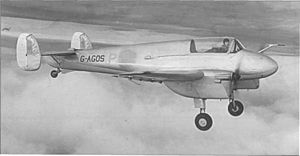Reid and Sigrist R.S.3
| R.S.3 Desford/R.S.4 Bobsleigh | |
|---|---|
 |
|
| Reid and Sigrist R.S.3 c. 1945 | |
| Role | Trainer |
| Manufacturer | Reid and Sigrist |
| Designer | Charles Bower |
| First flight | 9 July 1945 |
| Introduction | 1945 |
| Status | Cancelled |
| Primary user | Royal Air Force (intended) |
| Number built | 1 |
| Developed from | Reid and Sigrist R.S.1 |
The Reid and Sigrist R.S.3 was a British twin-engined, three-seat advanced trainer developed in the Second World War for postwar use. Although the R.S.3 was evaluated as a trainer, the type never entered production and was eventually rebuilt as the R.S.4 Bobsleigh as an experimental aircraft with the pilot in a prone position, seen as advantageous in minimising g-force effects in fighters.
Reid and Sigrist in Desford, Leicestershire, England, were an important instrument manufacturer in the interwar era, specialising in aircraft applications leading to the forming of an aviation division in 1937 at the New Malden, Surrey factory site. The first product was a twin-engined advanced trainer, the R.S.1 Snargasher (1939) which was eventually relegated to company hack used primarily at the factory and Desford aerodrome.
The follow-up design, the R.S.3 Desford (taking its name from the company site) was similar in size and concept to its predecessor although it was only configured for a pilot and trainee and featured a low-set wing. The S.R.3 was powered by two 130 hp de Havilland Gipsy Major Series I engines, rather than the higher powered de Havilland Gipsy Six engines of the earlier R.S.1. The overall shape was more pleasing than the dumpy R.S.1 and the pleasant flying characteristics of the earlier machine were retained.
The prototype, registered as G-AGOS first flew on 9 July 1945, shortly before VJ Day. Evaluated as a private venture project by test pilots including famed postwar flyer, Janusz Żurakowski at the Aeroplane and Armament Experimental Establishment (A&AEE) at RAF Boscombe Down, the R.S.3 was generally found to be well suited as a multi-engine primary and intermediate trainer. However, RAF interest was lukewarm due to the glut of surplus wartime training aircraft available. The prototype appeared at the Farnborough Airshow in 1946, and was allocated to the Institute of Aviation Medicine but by May 1949, it was deregistered as a civilian aircraft, flying subsequently with RAF serial number VZ728.
...
Wikipedia
